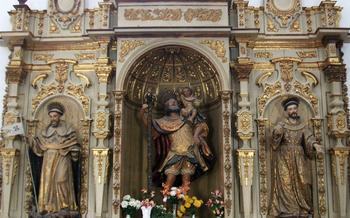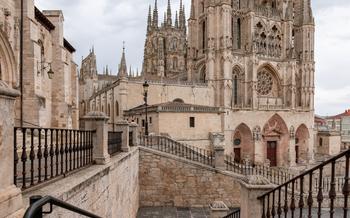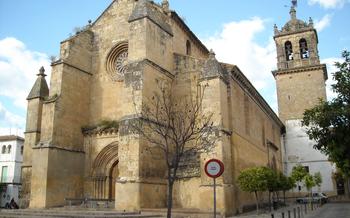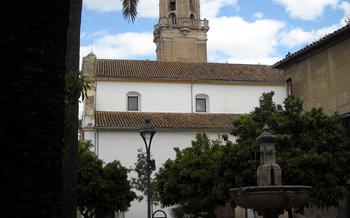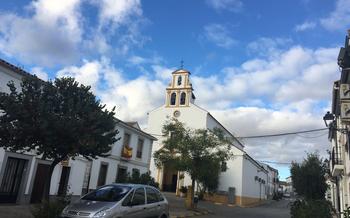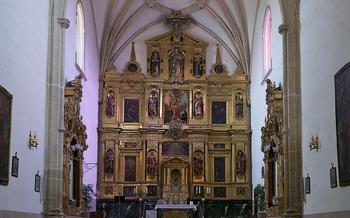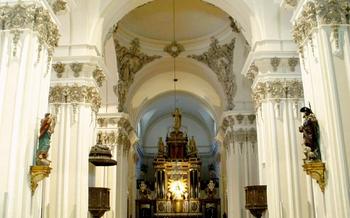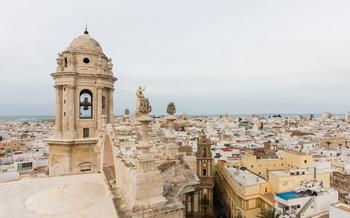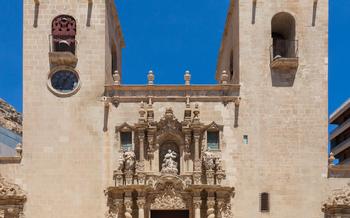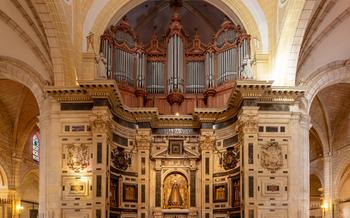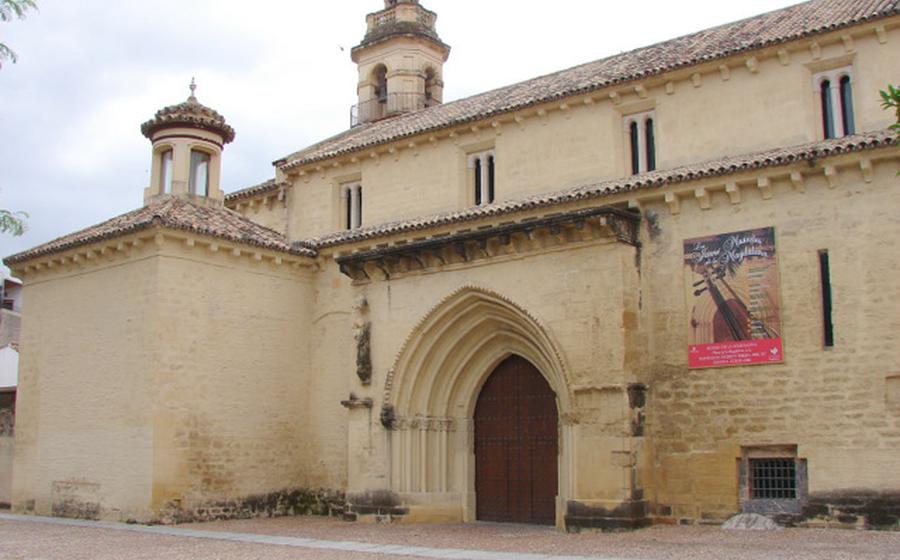
Iglesia de la Magdalena
- Iglesia de la Magdalena: A Monumental Treasure in Córdoba
- Step Inside the Church: A Journey Through Time
- Unveiling the History of the Magdalena Tower
- The Chapel of Santa Ana: A Place of Serenity
- Exploring the Legend of the Tears of the Virgin
- Uncovering the Secrets of the Crypt
- Admire the Exquisite Stained-Glass Windows
- Discovering the Renaissance Masterpieces
- The Church's Role in Local Celebrations
- Experiencing the Sounds of the Organ
- Visiting the Church Museum: A Treasure Trove of History
- Strolling Through the Picturesque Courtyard
- Photography Tips for Capturing the Church's Beauty
- Practical Information for Visitors:
- Insider Tip: Unveiling the Hidden Gem
Iglesia de la Magdalena: A Monumental Treasure in Córdoba
The Iglesia de la Magdalena stands as a testament to Córdoba's rich history and architectural prowess. Built in the 14th century on the site of an ancient mosque, the church has undergone several transformations over the centuries, blending Gothic, Renaissance, and Baroque elements into a harmonious ensemble. Its imposing façade, intricate carvings, and stunning bell tower make it one of the city's most iconic landmarks, attracting visitors worldwide.
Historical Background and Significance:
The Iglesia de la Magdalena holds a significant place in Córdoba's religious and cultural heritage. Originally constructed as a mosque, it underwent a transformation into a Christian church following the Reconquista of Córdoba in 123The church served as a prominent center of worship and community gatherings, witnessing countless religious ceremonies, weddings, and baptisms throughout its existence.
Architectural Features and Unique Characteristics:
The Iglesia de la Magdalena boasts a captivating blend of architectural styles, reflecting the city's diverse cultural influences. Its Gothic origins are evident in the pointed arches and ribbed vaults, while Renaissance and Baroque elements can be seen in the elaborate carvings, intricate ornamentation, and majestic bell tower. The church's unique features include the magnificent rose window, the stunning altarpiece depicting scenes from the life of Mary Magdalene, and the intricate portal adorned with biblical figures and symbols.
Religious Importance and Role in Local Traditions:
The Iglesia de la Magdalena holds a deep religious significance for the people of Córdoba. Dedicated to Mary Magdalene, one of Jesus's most devoted followers, the church has become a place of pilgrimage for those seeking spiritual guidance and comfort. Throughout the year, the church hosts numerous religious ceremonies, festivals, and processions, attracting devout believers and visitors from around the region.
Step Inside the Church: A Journey Through Time
As you cross the threshold of the Iglesia de la Magdalena, prepare to be captivated by its awe-inspiring interior. The grand nave, adorned with intricate plasterwork and delicate frescoes, leads your gaze towards the majestic altarpieces. The walls are lined with stunning paintings, each narrating a biblical tale or depicting a saint with intricate detail. The play of light filtering through the stained-glass windows casts a warm glow, illuminating the intricate carvings and sculptures that adorn every corner of the church.
The focal point of the interior is undoubtedly the main altarpiece, a masterpiece of Renaissance art. Its intricate carvings, vibrant colors, and lifelike figures depict scenes from the life of Jesus Christ, inviting you to contemplate their significance. The side altars, though smaller in size, are equally impressive, showcasing the talents of skilled artisans and the devotion of the faithful.
As you wander through the church, take a moment to admire the delicate choir stalls, intricately carved from wood and featuring scenes from the Bible. The pulpit, with its elegant lines and ornate decorations, is a testament to the craftsmanship of its makers. The baptismal font, with its intricate carvings and symbolic imagery, reminds visitors of the sacrament of baptism and the journey of faith it represents.
Unveiling the History of the Magdalena Tower
The Tower's Origins and Architectural Style
The Magdalena Tower stands as a testament to the architectural prowess of the Renaissance era. Constructed in the 16th century, the tower blends Gothic and Renaissance elements, creating a harmonious yet distinctive appearance. Its sturdy base, reminiscent of a fortress, transitions into an elegant octagonal shaft adorned with intricate carvings and moldings. The tower's design reflects the transition from defensive to decorative architecture, showcasing the changing priorities of the city.
The Role of the Tower in the City's Defense
In medieval times, Córdoba faced constant threats of invasion. The Magdalena Tower, with its strategic location and imposing structure, played a crucial role in the city's defense. Its height provided a vantage point for spotting approaching enemies, while its thick walls and narrow windows offered protection from projectiles. The tower's formidable presence served as a deterrent to potential aggressors, contributing to the city's safety and security.
The Tower's Transformation into a Bell Tower
Over time, Córdoba's defensive needs diminished, and the Magdalena Tower underwent a transformation. Its military purpose gave way to a more spiritual one as it became a bell tower. The addition of bells, with their melodious chimes, signaled the passing of time, called the faithful to prayer, and marked significant events in the city's life. The tower's new role symbolized the increasing importance of religion and the growing influence of the Church in shaping the city's identity.
The Chapel of Santa Ana: A Place of Serenity
Tucked away within the confines of the Iglesia de la Magdalena lies a hidden gem known as the Chapel of Santa Ana, a sanctuary of tranquility and devotion. This chapel, dedicated to the mother of the Virgin Mary, holds a significant place in the hearts of the local faithful. Its history is deeply intertwined with the church itself, dating back to the 14th century when it served as the parish church of the Magdalena neighborhood.
The architectural features of the chapel are a testament to the Gothic style prevalent during its construction. Its ribbed vaults, pointed arches, and intricate stonework create a sense of awe and reverence. The chapel's design exudes simplicity and elegance, with clean lines and a harmonious balance of elements.
Within the chapel, visitors are captivated by the artwork and religious iconography that adorn its walls and altars. The altarpiece, a masterpiece of Renaissance art, depicts scenes from the life of Saint Anne and the Virgin Mary, rendered with exquisite detail and vibrant colors. The stained-glass windows, bathed in hues of blue and gold, cast a warm and ethereal glow upon the chapel's interior, transforming it into a sacred space of contemplation and prayer.
Exploring the Legend of the Tears of the Virgin
The legend of the Tears of the Virgin is a captivating tale deeply intertwined with the history of the Iglesia de la Magdalena. It is said that in the 13th century, during the reign of King Alfonso X, a terrible plague swept through Córdoba, decimating the population. In the midst of this tragedy, the Virgin Mary appeared to a devout woman named María Ruiz de Alarcón, shedding tears of compassion for the suffering of her people.
The Virgin's tears fell upon a stone slab in the church, leaving an imprint that can still be seen today. This miraculous event instilled hope and faith in the hearts of the people, providing solace and strength during a time of great despair. The stone slab, known as the "Losa de las Lágrimas" (Slab of Tears), has become a symbol of the Virgin's love and protection, attracting pilgrims and visitors from far and wide who come to pay homage and seek her blessings.
Over the centuries, the legend of the Tears of the Virgin has been passed down through generations, becoming an integral part of the church's history and a testament to the enduring power of faith. It serves as a reminder of the Virgin's compassion and her willingness to intercede on behalf of those who call upon her in times of need.
Uncovering the Secrets of the Crypt
Beneath the Iglesia de la Magdalena, a hidden realm awaits discovery—the crypt. Once used for burials, this subterranean chamber now serves as a repository of history and secrets. Descend the stone steps and enter a world of ancient echoes. The crypt's vaulted ceilings and sturdy pillars evoke a sense of solemn reverence. Its walls are lined with niches, each once housing the remains of a departed soul. The air is cool and damp, carrying whispers of the past. Here, one can almost hear the prayers and chants that once resonated within these hallowed grounds.
The crypt's architectural elements, such as its groin vaults and pointed arches, hint at its Gothic origins. These features, reminiscent of medieval cathedrals, create a distinct atmosphere of spirituality. As you explore further, you'll encounter intricately carved tombs and funerary inscriptions, each telling a tale of life and loss. Some bear the names and titles of prominent figures from Córdoba's history, while others simply evoke the memory of ordinary individuals who once walked these streets.
The crypt's significance extends beyond its role as a burial site. It also served as a place of religious rituals and ceremonies. Here, the faithful gathered to pray for the departed, to seek solace in times of grief, and to commemorate the lives of those who had passed on. The crypt's somber ambiance and historical resonance make it a captivating destination for those seeking an encounter with the hidden depths of the Iglesia de la Magdalena.
Admire the Exquisite Stained-Glass Windows
The Iglesia de la Magdalena is renowned for its exquisite stained-glass windows, which illuminate the interior with vibrant colors and intricate designs. These magnificent windows are a testament to the skill and artistry of the craftsmen who created them.
The windows depict a variety of biblical scenes and stories, bringing the scriptures to life for the faithful. The vivid colors and intricate details of the windows create a sense of awe and wonder, inviting visitors to contemplate the mysteries of faith.
The stained-glass windows were created using the traditional technique of lead came construction. This technique involves using lead came, or strips of lead, to hold the individual pieces of glass together. The lead came is then soldered together to create a strong and durable framework.
The colors of the windows are achieved by using different types of glass. The most common type of glass used in stained-glass windows is pot metal glass. Pot metal glass is made by adding metal oxides to molten glass, which gives the glass its color.
The stained-glass windows of the Iglesia de la Magdalena are a true masterpiece of craftsmanship and artistry. They are a testament to the beauty and power of faith, and they continue to inspire visitors from all over the world.
Discovering the Renaissance Masterpieces
The Iglesia de la Magdalena boasts a remarkable collection of Renaissance artwork that adds to its cultural and artistic significance. During the Renaissance period, Córdoba, like many other cities in Spain, experienced a flourishing of artistic expression and creativity. This period witnessed the emergence of talented artists who left their mark on the city's churches and monuments.
The church's interior is adorned with several paintings and sculptures that exemplify the Renaissance style. The works showcase the characteristic techniques and aesthetics of the period, including meticulous attention to detail, vibrant colors, and realistic depictions of human figures. Visitors can admire the works of renowned Renaissance artists, such as Pedro de Campaña and Pablo de Céspedes, whose contributions have enriched the church's artistic heritage.
The presence of Renaissance masterpieces in the Iglesia de la Magdalena underscores its role as a repository of artistic and cultural treasures. These works not only enhance the beauty of the church but also provide a glimpse into the artistic and intellectual currents that shaped Córdoba during the Renaissance era.
The Church's Role in Local Celebrations
The Iglesia de la Magdalena plays an integral role in the religious festivals and processions that take place throughout the year in Córdoba. During these vibrant celebrations, the church becomes the focal point of community gatherings and spiritual devotion.
One of the most significant events is Semana Santa (Holy Week), a solemn commemoration of the Passion of Christ. During this time, the church hosts processions that wind through the streets of Córdoba, featuring elaborate floats carrying religious imagery and accompanied by penitents in traditional robes. The atmosphere is both somber and awe-inspiring as the community comes together to remember the sacrifice of Jesus Christ.
Another important occasion is the Feria de Córdoba, a springtime festival characterized by vibrant colors, lively music, and dancing. The church participates in the festivities by hosting traditional religious services and organizing processions that showcase the city's rich cultural heritage. The streets surrounding the church are transformed into a bustling marketplace, where vendors sell local delicacies and souvenirs, adding to the festive atmosphere.
These religious celebrations provide an opportunity for the community to come together, honor their faith, and celebrate the rich traditions of Córdoba. The Iglesia de la Magdalena stands as a symbol of unity and spirituality, bringing people from all walks of life together to share in these meaningful events.
Experiencing the Sounds of the Organ
Within the hallowed halls of the Iglesia de la Magdalena, a remarkable instrument resides—the church's majestic organ. This grand masterpiece, with its intricate pipes and commanding presence, has played a pivotal role in the church's history.
Crafted by skilled artisans, the organ boasts a rich, resonant sound that reverberates through the church's vast interior, enveloping listeners in a symphony of divine melodies. Its powerful tones have accompanied countless religious ceremonies, weddings, and special events, adding a touch of grandeur and solemnity to these sacred occasions.
Throughout the centuries, renowned organists have graced the church with their virtuosic performances, filling the air with enchanting music that stirs the soul. From classical compositions to contemporary pieces, the organ's repertoire is as diverse as it is captivating.
For visitors seeking a truly immersive experience, attending an organ concert at the Iglesia de la Magdalena is a must. As the organist's fingers dance across the keys, the church transforms into a concert hall, where the music takes center stage, transporting listeners to a realm of beauty and transcendence.
Visiting the Church Museum: A Treasure Trove of History
Delve into the depths of history and spirituality as you step into the captivating Church Museum, a hidden gem nestled within the Iglesia de la Magdalena. This treasure trove of religious artifacts and artwork beckons you to embark on a journey through time, unveiling the rich heritage of this sacred space.
The museum's collection is a testament to the profound devotion and artistry that have graced the church throughout the centuries. Gaze upon intricate sculptures, paintings, and liturgical objects, each piece a masterpiece in its own right. These artifacts whisper tales of faith, hope, and the enduring power of the human spirit.
Among the highlights of the collection is a stunning array of vestments, delicately embroidered with gold and silver threads. These ornate garments, once worn by priests and other religious figures, shimmer with an ethereal glow, evoking the grandeur of past ceremonies.
The museum also houses a collection of rare books and manuscripts, their pages filled with the wisdom and knowledge of generations past. These precious volumes offer a glimpse into the intellectual and spiritual pursuits that have shaped the history of the church.
As you wander through the museum's exhibits, you'll gain a deeper appreciation for the significance of the Iglesia de la Magdalena, not just as a place of worship but also as a repository of cultural and artistic heritage. It's a place where the past and present intertwine, inviting you to connect with the enduring spirit of this sacred sanctuary.
Strolling Through the Picturesque Courtyard
As you step into the courtyard of the Iglesia de la Magdalena, a sense of tranquility and serenity envelops you. The courtyard, a hidden gem tucked away from the bustling city streets, offers a peaceful oasis for contemplation and reflection.
The courtyard's design exudes simplicity and elegance, with its rectangular shape and symmetrical layout. The whitewashed walls, adorned with intricate carvings and moldings, create a harmonious backdrop for the lush greenery that flourishes within.
In the center of the courtyard, a graceful fountain provides a soothing melody as water gently cascades into its basin. Surrounding the fountain, vibrant flowers of various colors and shapes add a splash of vibrancy to the serene space.
The courtyard also features several arched doorways that lead to different parts of the church, as well as a staircase that ascends to the upper levels. These architectural elements, combined with the intricate details of the surrounding walls, create a visually captivating scene that draws the eye.
Whether you choose to sit on one of the benches and soak in the tranquil atmosphere or simply wander around, admiring the courtyard's beauty, this hidden gem offers a unique and memorable experience for visitors.
Photography Tips for Capturing the Church's Beauty
To capture the breathtaking beauty of the Iglesia de la Magdalena through photography, it's essential to approach the task with a keen eye and the right techniques. For the exterior shots, position yourself at an angle to showcase the church's grandeur, utilizing a wide-angle lens to encompass its entirety. Experiment with different camera settings, adjusting the aperture and shutter speed to achieve the desired depth of field and motion blur.
When venturing inside, switch to a wide-angle or standard lens to capture the church's awe-inspiring interior. Focus on the intricate details, such as the intricate carvings, delicate moldings, and stunning stained-glass windows. Use natural light streaming through the windows to create dramatic lighting effects and enhance the vibrancy of the colors.
To capture the essence of the stained-glass windows, position yourself directly beneath them, allowing the light to illuminate the intricate details and vibrant hues. Experiment with different shutter speeds to freeze the movement of people walking below or create a sense of motion by capturing the interplay of light and shadow.
Remember, patience and experimentation are key to capturing the true beauty of the Iglesia de la Magdalena. Take your time, explore different angles and lighting conditions, and let the church's unique charm guide your photographic journey.
Practical Information for Visitors:
Plan your visit to the Iglesia de la Magdalena with these essential tips:
-
Opening Hours: The church is open to the public daily, with varying hours depending on the season. Be sure to check the official website or local tourist information centers for the most up-to-date hours.
-
Admission Fees: Entrance to the church is free of charge, allowing you to explore its beauty without any financial burden. However, donations are graciously accepted to support the church's upkeep and preservation.
-
Guided Tours: Guided tours of the church are available, offering a deeper insight into its history, architecture, and religious significance. These tours are typically offered in multiple languages and provide an excellent opportunity to learn more about this magnificent monument.
-
Accessibility: The church is committed to providing an accessible environment for all visitors. Wheelchair ramps and elevators are available to ensure that everyone can comfortably explore the church's interior.
-
Dress Code and Behavior: As a place of worship, visitors are expected to dress respectfully and behave appropriately within the church. Please be mindful of the sacred nature of the space and refrain from loud noises or disruptive behavior.
Insider Tip: Unveiling the Hidden Gem
While exploring the wonders of the Iglesia de la Magdalena, take a moment to venture off the beaten path and uncover a hidden gem within its sacred walls: the Chapel of San Bartolomé. Tucked away from the main tourist routes, this intimate chapel offers a serene sanctuary for reflection and spiritual connection.
Step inside the Chapel of San Bartolomé, and you'll be greeted by a tranquil atmosphere that invites contemplation. The muted light filtering through the stained-glass windows casts a soft glow upon the chapel's interior, creating a sense of awe and reverence. Admire the intricate carvings and delicate frescoes adorning the walls, each telling a story from the life of Saint Bartholomew.
At the heart of the chapel lies a remarkable altarpiece, a masterpiece of Renaissance artistry. Crafted with meticulous detail and vibrant colors, the altarpiece depicts scenes from the saint's life, capturing his unwavering faith and devotion. Take a moment to study the intricate details of each panel, marveling at the skill and craftsmanship of the artist.
The Chapel of San Bartolomé is a hidden gem within the Iglesia de la Magdalena, offering a unique and intimate experience for visitors seeking a deeper connection to the church's history and spirituality. Discover the tranquility and beauty of this sacred space, and let its serene atmosphere wash away the stresses of everyday life.
